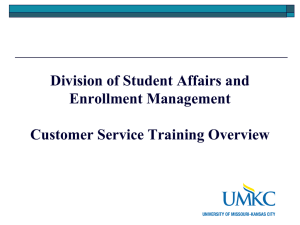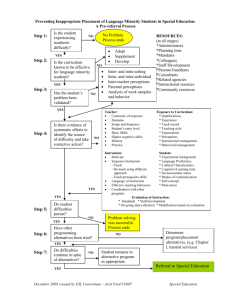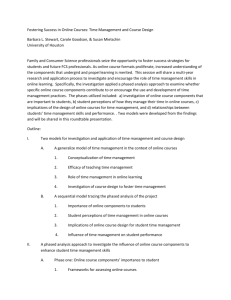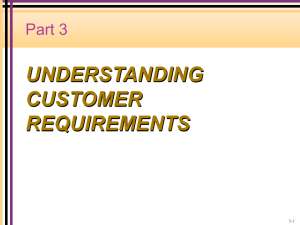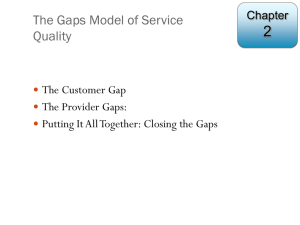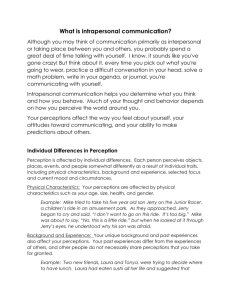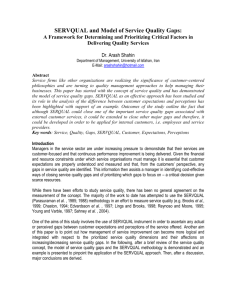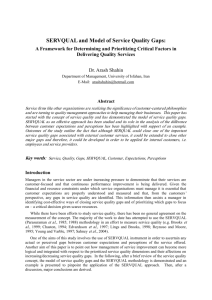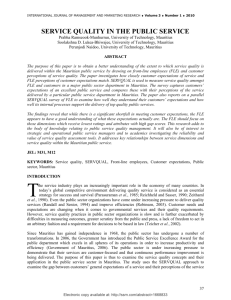DOC - Faculty Personal Homepage
advertisement
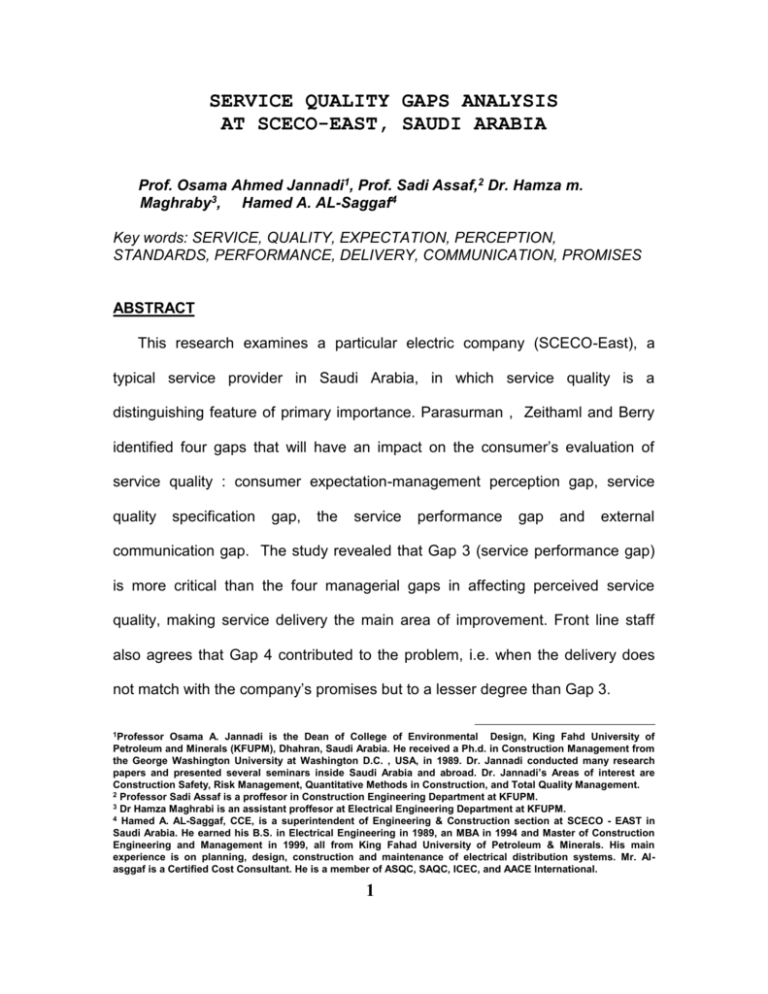
SERVICE QUALITY GAPS ANALYSIS AT SCECO-EAST, SAUDI ARABIA Prof. Osama Ahmed Jannadi1, Prof. Sadi Assaf,2 Dr. Hamza m. Maghraby3, Hamed A. AL-Saggaf4 Key words: SERVICE, QUALITY, EXPECTATION, PERCEPTION, STANDARDS, PERFORMANCE, DELIVERY, COMMUNICATION, PROMISES ABSTRACT This research examines a particular electric company (SCECO-East), a typical service provider in Saudi Arabia, in which service quality is a distinguishing feature of primary importance. Parasurman , Zeithaml and Berry identified four gaps that will have an impact on the consumer’s evaluation of service quality : consumer expectation-management perception gap, service quality specification gap, the service performance gap and external communication gap. The study revealed that Gap 3 (service performance gap) is more critical than the four managerial gaps in affecting perceived service quality, making service delivery the main area of improvement. Front line staff also agrees that Gap 4 contributed to the problem, i.e. when the delivery does not match with the company’s promises but to a lesser degree than Gap 3. 1Professor Osama A. Jannadi is the Dean of College of Environmental Design, King Fahd University of Petroleum and Minerals (KFUPM), Dhahran, Saudi Arabia. He received a Ph.d. in Construction Management from the George Washington University at Washington D.C. , USA, in 1989. Dr. Jannadi conducted many research papers and presented several seminars inside Saudi Arabia and abroad. Dr. Jannadi’s Areas of interest are Construction Safety, Risk Management, Quantitative Methods in Construction, and Total Quality Management. 2 Professor Sadi Assaf is a proffesor in Construction Engineering Department at KFUPM. 3 Dr Hamza Maghrabi is an assistant proffesor at Electrical Engineering Department at KFUPM. 4 Hamed A. AL-Saggaf, CCE, is a superintendent of Engineering & Construction section at SCECO - EAST in Saudi Arabia. He earned his B.S. in Electrical Engineering in 1989, an MBA in 1994 and Master of Construction Engineering and Management in 1999, all from King Fahad University of Petroleum & Minerals. His main experience is on planning, design, construction and maintenance of electrical distribution systems. Mr. Alasggaf is a Certified Cost Consultant. He is a member of ASQC, SAQC, ICEC, and AACE International. 1 1.0 INTRODUCTION Quality in a service organization is a measure of the extent to which a delivered service meets the customer’s expectations. It is determined by the customer’s perception and not by the perceptions of the providers of the service. It is, therefore, very important to determine customer needs & wants and, then design the service to meet these requirements. Service quality is considered a critical determinant of competitiveness. Service quality can help an organization to differentiate itself from other organizations and gain a competitive advantage. Superior service quality is a key to improved profitability. Saudi Consolidated Electric Company in the Eastern Province (SCECOEAST) is the largest electrical utility in Saudi Arabia. It serves the Eastern region from Hafr al-batin and its villages north to Salwa on the Qatar border, and from the Arabian Gulf east to the border of central province. The main system’s peak demand for 1998 was 7703 MW while the generation capacity amounted to 8773 MW. In 1998, power was supplied to 19,424 new customers. This figure, representing a 3.9 % increase over the previous year, has brought the total number of customers by the end of 1998 to 519,558. The percentages of power consumption by customer type are: Saudi Armco 26%, Industrial 25%, SCECO-Central 17%, Residential 20%, Government 7% and Commercial 5 %, bringing total power sales to 46,407,108 Megawatts-hour. SCECO-EAST is one of these utilities that hoped that it would be able to provide better service if it promoted a greater understanding of service quality issues in this industry. SCECO-East applied SERVQUAL, a methodology for measuring customers’ perceptions of service quality. The perceived quality is the 2 customer’s feelings about the quality of the service. It determines the extent of the customer’s satisfaction. It is the results of comparing the prior expectations with the actual service received. The prior customer expectation is the established image of what will be received when the consumer requests a service, while the actual quality is the real level of service quality provided. The actual service is determined and controlled by the provider of the service. It is, therefore, necessary to set standards of service quality characteristics, i.e. determinants of service quality (Ghobadian et al. 1994). SCECO-East measured level of service quality by asking their customers about their expectations and perceptions of actual performance over determinants of service quality i.e. tangibles, reliability, responsiveness, assurance and empathy. The mismatch between customer expectation and perception of actual service constitute SERVQUAL scores. The mean score for the expectations component was 6.25 and for perceptions is 5.59 on a sevenpoint scale. SERVQUAL scores, which can be ranged from –6 to +6 on which zero implies that consumer perceptions and expectations coincide, negative values imply perceptions fall short of expectations and positive values imply perceptions exceed expectations, has a mean of –0.65. The mean of -0.65 for the SERVQUAL measure implies that on average respondents’ perceptions fell short of their expectations, which is logical if expectations are considered ideal. The average minimum value of SERVQUAL for all customers is –4.76, while the maximum is 2.81. Lower negative gap scores imply high level of perceived service quality, i.e. customer perceptions come closer to matching expectations. 3 SCECO-East took matters a step further to investigate factors behind this lag between customers’ expectations and their perceptions. The primary objective of the research is to investigate the quality shortfall within the SCECOEast organization and between SCECO-East and its customers and then improve the understanding of the characteristics, structure and the performance of SCECO-East. Several quantifiable measurements were made by surveying SCECO-East managers and staff. This paper describes a detailed survey and analysis in the light of the model put forward by Parasurman , Zeithaml and Berry (PZB) . The purpose of the empirical study is to offer a conceptual framework summarizing the unique characteristics and culture at SCECO-EAST organization, to report the findings of the survey conducted to measure gaps in services provided, to review potential problems from an empirical study and to offer recommendations exploring the ways in which SCECO-East may identify and exploit opportunities to improve its services. The paper will measure the four gaps in perceptions, including the gaps within the service provider and between the client and the organization (service quality gap model). Recommendations regarding each of the gaps will be proposed after analyzing the collected data. 2.0 The Service Quality Gap Model The GAP model was developed by Parasuraman , Zeithamal and Berry in order to show the salient activities of the service organization that influence the perception of quality. The proposed conceptual model is based on interpretation 4 of qualitative data generated through a number of in-depth executive interviews and consumer focus groups. It shows the interaction between key activities and identifies the linkages between these activities of the service organization, which are pertinent to the delivery of a satisfactory level of service quality. The gap service quality model (Fig.1) measures five gaps in perceptions, including gaps within the service provider, within the client and between each party. The links are described as gaps or discrepancies, which represent a significant service quality. A gap represents a significant hurdle to achieving a satisfactory level of service quality. Gaps 2, 3 and 4 related to issues that are internal to the service provider and involve organizational culture, while gap 5 is purely an external one (within the clients). Gap 1 involves both parties. This means that while gap 5 requires purely external measurement all other gaps require internal measurement. The consumer’s view of service quality is shown in the upper part. Service quality as perceived by a consumer depends on the size and direction of gap 5 which in turn, depends on the nature of the gaps associated with the design and delivery of services: GAP 5 = f (gap 1, gap 2, gap 3,gap 4) The four discrepancies or gaps on the provider side (lower part) of the equation can be favorable from service quality perspective. That is, the magnitude and direction of each gap will have an impact on service quality. Set of factors potentially affecting the magnitude and direction of the provider’s side. Most of these factors involve communication and control processes implemented in organizations to manage employees. Other factors involve consequences of 5 these processes (i.e. role ambiguity and role conflict) that affect the delivery of service quality. Fig. 2 is an extended model of service quality, showing the various organizational constructs and their relationships to the service quality gaps. The gaps are described in detail below: GAP 1: Consumer Expectation - Management Perception Gap. This gap arises when management does not know what customers expect or have inaccurate perceptions of what consumers actually expect. The wrong perceptions arise when management misinterpret, under estimate or fail to understand customers’ requirements. Service firm executives may not always understand what features connote high quality to consumers, what attributes a service must have in order to meet consumer needs, and what levels of performance on those features are necessary to deliver high quality service (Zeithmal et al.1988). PZB (1985) found that lack of understanding of the executive perceptions about what consumers expect in a quality service might affect quality perceptions of consumers. They proposed ”the gap between consumer expectations and management perceptions of these expectations will have an impact on the consumer’s evaluation of service quality” (Ghobadian et al. 1994). Because there are few clearly defined and tangible cues for services, the gap between what consumers expect and what managers think they expect may be considerably larger than it is in firms that produce tangible goods. Zeithaml believed that this 6 gap might be larger in services than in manufacturing companies, because services have few clearly defined and tangible cues (Cronin and Taylor 1992). In equation form: GAP 1 = Customer Expectations - Management Perceptions of Customer Expectation. The lower the difference, the better, i.e. management’s show excellent understanding of customers’ needs. ZBP (1988) proposed that the size of gap 1 is related to (Zeithaml1988): (a) Extent of marketing research orientation (-). (b) Extent of quality of upward communication (-). (c) Levels of management (+). The positive and negative signs in parentheses indicate the direction of increasing or decreasing the size of the gap. Positive direction means that the gap will increase as that factor increases while negative direction means as the factor increases the gap will tend to be reduced. GAP 2 : Service Quality Specification Gap. This is the GAP between managers’ perceptions of customers’ service expectations and the quality standards they establish to translate those perceptions into specifications for delivering the appropriate level of service. It arises when the management is unable to translate customer expectations into service quality specifications. It relates to aspects of service design. PZB (1985) found the difficulty experienced in attempting to match or exceed consumer 7 expectations. It is difficult to establish specifications to deliver quick response consistently because of lack of trained service personnel and fluctuations in demand. Another reason for the gap between expectations and actual specification is due to management commitment to service quality (Parasuraman et al.1985). Variety of factors: resource constraint, market conditions (i.e. peak demand in summer season), and management indifference may result in a discrepancy between management perceptions of consumer expectations and the actual specifications established for a service [(Parasuraman et al. 1985). PZB (1985) proposed that the gap between management perceptions of consumer expectation and the firm’s service quality specifications would affect service quality from the consumer’s viewpoint. In equation form: GAP 2 = Management’s Perception of CEs - Service Quality Specifications. The lower the difference, the better, i.e. management perfectly translates cues into service quality specifications. ZBP 1988, proposed that the size of gap 2 is related to: (a) Management commitment to service quality ( - ). (b) Setting of goals relating to service quality ( - ). (c) Task standardization ( - ). (d) Perception of feasibility for meeting customer expectations ( - ). 8 GAP 3: The Service Performance (Delivery) Gap. Gap 3 is the discrepancy between the specifications for the service and actual delivery of the service. It is referred as the service performance gap, that is, the extent to which service providers do not perform at the level expected by management (Zeithaml 1985). This gap arises when guidelines for service delivery do not guarantee high quality service delivery or performance. It measures the performance gap between service specifications and service delivery. The size of this gap depends upon employees’ willingness and ability to perform at the appropriate level. Even when guidelines exist for performing services well and treating consumers correctly, high quality service performance may not be a certainty. A service firm’s employees exert a strong influence on the service quality perceived by consumers and the employee performance cannot always be standardized. “Every thing involves a person, so it is hard to maintain standardized quality” (Parasuraman et al.1994). However, each firm reported difficulty in adhering to these standards’ because of the variability in employee performance. PZB (1985) proposed that the gap between service quality specifications and actual service delivery would affect service quality from the consumer’s standpoint. They state that organizations with multiple sites and labor-intensive service applications are most likely to experience this gap. Gap 3 will be favorable when actual service delivery exceeds specifications. It will be unfavorable when service specifications are not met. In equation form: 9 GAP 3 = Service Quality Specification - Service Delivery. The lower the difference, the better, i.e. an employee is perfectly able to deliver the appropriate service level. The main theoretical constructs proposed to account for the size of gap 3 are (Zeithaml et al. 1988): (a) Extent of teamwork perceived by employee (-) (b) Employee job fit (-). (c) Technology job fit (-). (d) Extent of perceived control experienced by customer contact personnel (-). (e) Extent to which behavioral control systems are used to supplement output control systems (-). (f) Extent of role conflict experienced by customer contact personnel (+), and (g) Extent of role ambiguity experienced by customer contact personnel (+). GAP 4 : External Communication Gap. This gap arises when promises do not match service delivery. Overstating the level of service (promising more than you can deliver) will quickly lead to customer dissatisfaction and complaints. Media advertising, word of mouth and other communications by a firm can affect consumer expectations. Since expectations play a major role in consumer perceptions of service quality, the firm must be certain not to promise more in communications that it can deliver in reality. Promising more than can be delivered will raise initial expectations that 10 lower perceptions of quality when the promises is not fulfilled (Parasuraman et al. 1985). Consumers are not always aware of every thing done behind the scenes to serve them well. Consumers who are aware that a firm is taking concrete steps to serve their best interests are likely to perceive a delivered service in a more favorable way. Consumer expectations are fashioned by the external communications of an organization. A realistic expectation will normally promote a more positive perception of service quality. So, a service organization must ensure that its marketing and promotion material accurately describes the service offering and the way it is delivered. To sum up, external communication can affect not only consumer expectations about a service but also consumer perceptions of the delivered service. PZB (1985) proposed that the gap between actual service delivery and external communications about the service will affect service quality from a consumer’s standpoint. In equation form : GAP 4 = Service Delivery - External Communication to customers. The lower the gap, the better i.e. the promotion program of the company accurately describes the service delivered. ZBP (1988) proposed that the size of gap 4 is related to : (a) Extent of horizontal communication ( - ). (b) Propensity to over promise ( + ). 11 3.0 Methodology Two surveys have been conducted for this project: one amongst SCECO- East's supervisors in the company and the second amongst the contact personnel (front line staff). The front-line staff and the principals and the supervisory staff were selected at random. For the frontline staff survey, a sample size of 200 ( about 40 % of total population) was chosen. A total of 117 (59 %) completed questionnaires were collected for the current research. For supervisory staff, a random sample of 20 principals and supervisors that have contacts with customers was selected. Of the original 20 questionnaires, 12 (60 %) were returned and usable. The Frontline staff questionnaire contained statements capturing the essence of what literature suggests are specific variables of antecedents of gaps related to service performance and difference between service delivery and external communication. Similarly, supervisory questionnaire contained statements to predict the difference of management perceptions of customer expectations and specific variables of antecedents for the wrong service quality standards. Respondents were asked to indicate on a scale of 1 (very low) to 7 (very high) the extent to which they felt each item was the performance of SCECO-East. Mean score for each specific variable was calculated by averaging all responses in the sample size for that variable. 12 4.0 Analysis 4.1 GAP 1 – Not Knowing What Customers Expect GAP 1 Score Gap 1 is defined as the managers’ perceptions of customer expectations minus the customers’ expectations. It measures how well the service provider knows what his customers expect. Table 1 compares principals’ perceptions of customers’ requirements with those declared by customers over five service quality dimensions namely: Tangibles, Reliability, Responsiveness, Assurance (competence, courtesy, credibility, security) and Empathy (access, communication, understanding of the customer) which is defined below: 1. Tangibles : These include the appearance of physical facilities, equipment, personnel, communications, use of appropriate materials, etc. Tangibles are more important in high contact services, i.e. 2. Reliability : conditions of the buildings. It is the ability to provide the promised service dependably and accurately. For example, in the case of electrical utilities, this means fewer or no power outages to customers. 3. Responsiveness : It is the ability to deal effectively and promptly with customer requirements and complaints. For example, in the case of electrical utilities, prompt repair of power outages and providing temporary supply during outages. 4. Assurance: Knowledge, experience, courtesy and readiness to maintain client confidence and trust. 5. Empathy : It involves caring and providing individualized attention to customers. 13 It is interesting that there is agreement between customers and principles on several dimensions. The slight disparity indicates that the service quality needs of customers are not being fully identified for dimensions of tangibles, assurance and empathy. A positive score for reliability indicates that management are greatly concerned about this dimension and consider it as the most important with respect to customers. Empathy, which is rated with least expectation score by both principals and customers, indicates that both management and customers do not expect individualized and personal attention by contact employees during service delivery. There may be two plausible reasons for this. First, SCECO-East is considered as a government monopoly agency and customers would not expect personalized attention by SCECO-East employees. Secondly, SCECO-East principals think that services provided to customers are standards in nature and there is no chance for customization. Management Perceptions of Customer Expectations Table 2 reports mean scores of management perceptions of customers’ expectations. The total mean item for the expectations component of 21 features is 6.11. This measure is lower than the mean reported by customers which is 6.25, meaning that SCECO-East management slightly underestimates customers’ expectations. Judging from the average responses for managers’ perceptions of customer expectations for the 21 service features, two features received extremely high average responses, indicating that SCECO-East management felt them to be of most importance to the customers. These are: providing services at the time they promise to do (a reliability feature) and having 14 convenient operating hours (an empathy feature). While all scores are high (more than 5.50 on a scale of 7), two features were rated by principles as the least important to customers. These are: employees being neat in appearance (a tangible feature) and having customers’ best interest in mind (an empathy feature). Comparing these results of management perception of customers’ expectations with those obtained earlier from customers, we could have the following inferences: 1. SCECO-East management underestimates more than 50% of 21 service features. column. This is shown in minus signs in the fourth The higher the negative difference, the more gap in knowing customer expectations by the management. 2. While some items rated highest by customers, SCECO-East management rated these items with lowest scores. One example is “employees to be neat in appearance”, rated by customers as the second essential feature, while SCECO-East managers rated it the least important feature. Antecedents of Gap 1 The reasons for Gap 1 are lack of marketing research, inadequate upward communication and too many levels of management. SCECO-East management view the number of management levels as the main source of this gap (Table 3). Table 4 shows the specific variables responsible for gap 1. The increased number of management levels between top managers and contact 15 personnel affected the quality of communication between the two parties, which contribute to underestimating customers’ requirements by principals as the messages received from contact personnel are not clear. Overall Gap Between Managers and Customers One item was added in the principal’s survey to rate the gap between SCECO-East managers in understanding/knowing customers expectations. The overall gap, as rated by principals, between SCECO-East management and its customers was 4.71, on a 7-point scale where 7-represents the greatest size of discrepancy and 1-represents the lowest. 4.2 GAP 2 – The Wrong Service Quality Standards This is the gap between managers’ perception of customers’ expectations and the quality standards they establish to translate those expectations into specifications for delivering the appropriate level of service. Tables (5) and (6) show the factors and specific variables contributing to Gap 2. 4.3 GAP 3 – The Service Performance Gap This measure represents the performance gap between service specification and service delivery. The size of this gap depends upon employee willingness and ability to perform at the appropriate level. Table (7) shows the antecedents or the key contributing factors of gap 3. Frontline staff of SCECO-East rated “role conflict”, which relates to incompatible or too demanding expectations of top managers, immediate supervisors and customers over contact personnel, as the main problem (mean of 4.6 on 7 point scale) contributing to this gap. The other problem area is the “role ambiguity” (mean of 4.52) which relates to unclear 16 information necessary to perform jobs adequately and how employee performance will be evaluated and rewarded. Table (8) shows the specific variables responsible for each factor. “Extent to which employees perceive they are in control of their job” is perceived by frontline staff as the greatest variable responsible for the size of gap 3 (mean of 5.22). SCECO-East contact personnel perceive themselves to be not in control of situations they encounter in their jobs. The second highest variable responsible for gap 3 as perceived by frontline staff is the “amount of paper work needed to complete service transactions” with mean of 5.11. 4.4 GAP 4 – Difference Between Service Delivery and External Communications Promising customers more than the firm can deliver will quickly lead to customer dissatisfaction and complaints. The two key factors contributing to this gap are the inadequate horizontal communications and propensity to overpromise. Tables 9 and 10 show the antecedents and the specific variables of this gap. Horizontal communication which is represented by three specific variables in table 10, indicates the level of interaction between the employees in different departments of the firm. SCECO-East employees felt that awareness of external communications to consumers before they occur (i.e. frontline staff have no information about advertisements made by the firm to customers) and the differences of procedures across branches are the most important contributing issues of gap 4. 17 4.5 Comparison of Gap Sizes Table (11) compares sizes of Gaps 1, 2, 3 and 4 as viewed by SCECO-East supervisors and frontline staff. Front-line employees believe Gap 3 is the largest, i.e. when delivery does not match the company’s standards and specifications. Front line staff also agree that Gap 4 contributed to the problem, i.e. when the delivery does not match with the company’s promises but to a lesser degree than Gap 3. SCECO-East managers thought that they have an excellent understanding of customers’ perception (Gap 1) and excellently translated these requirements into quality standards and specifications. Both Gaps 1 and 2 scores were either below the mid-point scale or near the midpoint. The overall results are acceptable with a need to empower SCECO-East frontline staff to reduce the deficiency in service delivery (Gap 3). 5.0 Conclusions These four discrepancies or gaps can be major hurdles in attempting to deliver a service which consumers would perceive as being of high quality. The following are the conclusions drawn from the data analysis and discussions furnished earlier: Gap 1 The results identified the fact that more effort is needed to improve the management perception of customer expectations specially in tangibles and empathy dimensions. Managers should spend more time with frontline staff to improve their knowledge of customer requirements. In addition, there is a 18 need for “flattening out” with some layers of management being omitted. This is to improve the upward communication to allow clearer messages to be transmitted from frontline staff through a shorter path to top management. SCECO-East should conduct several studies to identify customers’ needs and the degree of satisfaction with existing service levels. Gap 2 Management need to be more committed to service quality and set longterm goals for quality. It is needed to establish quality indicators and to target staff to improve those indicators. Quality indicators may include time limit to complete an application, number of outages per year…etc. Gap 3 Services are performances, and most of the time it is people who render these performances [3]. For this reason, many service firm managers recognize the importance of service employees in communicating with and satisfying their customers. Three major issues namely; employee selection, control over personnel and employee empowerment need to be managed and controlled if service delivery is to be effective. The main area for improvement is eliminating the distress of role conflict. The result will be better employee performance and hence a reduction of gap 3. As role conflict is related positively to feelings of job-related tension and negatively to job satisfaction, SCECO-East management should use performance measurement systems that focus on the consumer and internal efficiency goals. They should tie the compensation to service quality delivery 19 as measured by performance measures. There also needs to be more management focus on downward communication to clearly direct and influence personnel at lower levels in the organization. The more frequently managers provide clear and unambiguous communication, the lower employees’ role ambiguity will be. Several other improvements such as empowering frontline staff to make decisions and the reduction of paper work are needed to complete transactions, which will improve the service delivery and will narrow gap 3. Gap 4 Frontline employees need to be aware of all company communications before they occur and participation in any campaign would result in more consumer expectations. SCECO-East management needs to enforce the coordination or integration of departments and different branches to achieve strategic objectives. SCECO-East should not allow managers of individual branches to make significant changes in procedures and policies as consumers may not receive the same level of service quality across the branches. The overall results of service quality gap is acceptable and customers state that SCECO-East is delivering a quality of service that closely matches their current perceptions (score of –0.65, where 0 is the reference when expectation and perception are met). While customers seem pleased with the overall service quality, SCECO-East cannot stand still as customers’ expectations are likely to increase over time. Gap 3 is more critical than the other four managerial gaps in 20 affecting perceived service quality and in explaining service quality variations. Because SCECO-East has multiple sites and it is a labor-intensive service, applications are most likely to be experienced this gap. This makes the main area of improvement on the part of service delivery. Training and empowering frontline staff to respond to customers is essential. SCECO-East should also create a favorable Gap 4 by employing effective external communications to create realistic consumer expectations and to enhance consumer perceptions. Maintaining a close relationship between SCECO-East and its customers would reduce gaps between expectations and delivered service. 21 Table (1): Gap 1 Service Dimension Tangibles Reliability Responsiveness Assurance Empathy Principals Customers Gap 1 6.04 6.36 6.28 6.21 5.97 6.26 6.19 6.29 6.37 6.15 -0.22 0.17 -0.01 -0.16 -0.18 22 Table (2): Mean Scores of Management Perceptions of Customer Expectations Item 1 2 3 4 5 6 7 8 9 10 11 12 13 14 15 16 17 18 19 20 21 Features Modern Equipment Physical facilities Neat – appearing Visually appealing materials Sincere in solving problems Perform right the first time Provide as they promise to do so Error free records Tell exactly when perform Prompt service Willing to help Never too busy to respond Instill confidence in customers Customers feel safe Courteous with customers Have knowledge to answer customer questions Give customers individual attention Have convenient operating hours Employees give customers personal attention Have the customers’ best interest at heart Understand specific needs of customers AVERAGE EXPECTATIONS 23 Differ -ence Manager Expect. 6.57 5.83 5.71 6.00 6.28 6.00 6.86 6.28 6.57 6.43 6.14 6.00 6.14 6.14 6.00 6.43 Customer Expect. 6.23 6.25 6.42 6.15 6.24 6.18 6.13 6.22 6.18 6.28 6.34 6.34 6.22 6.46 6.41 6.40 6.17 6.86 6.14 6.18 6.28 5.99 -0.01 0.58 0.15 5.71 6.06 -0.35 6.00 6.24 -0.24 6.11 6.25 -0.14 0.34 -0.42 -0.71 -0.15 0.04 -0.18 0.73 0.06 0.45 0.15 -0.20 -0.34 -0.08 -0.32 -0.41 0.03 Table (3): Antecedents of Gap 1 Item 1 Construct Direction* - Marketing Research Orientation 2 Upward Communication 3 Levels of Management + * Minus sign indicates that scores of these items were reversed in calculating the gap. 24 Mean Score 3.28 3.33 5.14 Table (4): Scores of Specific Variables of Gap 1 Item Variables Mean Score 1 2 3 Amount of improvement research Implementation of improvement research Degree to which improvement research focuses on service quality issues Extent of direct interaction between managers and external customers Extent of employee-to-manager communication Extent to which inputs from contact personnel are sought Quality of contact between top managers and personnel in contact with customers Number of layers between personnel in contact with customers and top managers 2.71 3.28 3.28 4 5 6 7 8 25 3.86 2.86 3.28 3.86 5.14 Table (5): Gap 2 Antecedents Item 1 Construct Direction* Mean Score Management commitment to 2.90 service quality 2 Goal-setting 3.28 3 Task standardization 2.86 4 Perception of feasibility 2.78 * Minus sign indicates that scores of these items were reversed in calculating the gap. 26 Table (6): Scores of Specific Variables of Gap 2 Item Variables Mean Score 1 2 3 4 Resource commitment to quality Existence of internal quality programs Management recognition for quality commitment Existence of a formal process for setting quality of service goals Use of technology to standardize operations Capabilities/systems for meeting specifications Extent to which managers believe consumers’ expectations can be met 2.71 2.86 3.14 3.28 5 6 7 27 2.86 2.71 2.86 Table (7): Antecedents of Gap 3 Item Construct Direction* Mean Score 1 Team Work 4.05 2 Employee – job fit 3.02 3 Technology-job fit 3.89 4 Perceived control 4.09 5 Supervisory control systems 3.83 6 Role conflict + 4.60 7 Role ambiguity + 4.52 *Minus sign indicates that score of these items were reversed in calculating the gap. 28 Table (8): Scores of Specific Variables of Gap 3 Item Variables 1 Extent to which employees view other employees as customers Extent to which contact personnel feel upper level managers genuinely care for them Extent to which contact personnel feel they are cooperating rather than competing Extent to which employees feel personally involved and committed Ability of employees to perform job Importance and effectiveness of selection process Appropriateness of tools and technology for performing job Extent to which employees perceive they are in control of their jobs Extent to which contact employees feel they have flexibility in dealing with customers Predictability of demand Extent to which employees are evaluated on what they do (behaviors) rather than solely on output quantity Amount of paper work needed to complete service transactions Number of internal contacts that contact-employee must make to complete a service transaction or answer customer queries Existence of management policy that conflicts with specifications Frequency and quality of downward communication Extent of constructive feedback given to contact personnel Product knowledge of contact personnel Product-specific training provided to contact personnel Training in communication skills provided to contact personnel 2 3 4 5 6 7 8 9 10 11 12 13 14 15 16 17 18 19 29 Direction - Mean Score 3.86 - 4.53 - 3.63 - 4.21 - 2.59 3.42 3.89 5.20 - 3.67 - 3.48 3.83 + 5.11 + 4.73 + 3.96 -- 4.87 4.76 3.52 4.78 4.78 Table (9): Antecedents of Gap 4 Item Constructs Mean Score 1 Horizontal communication 4.14 2 Propensity to over-promise 3.30 30 Table (10): Scores of Specific Variables of Gap 4 Item Variables Direction* - 1 Extent to which contact personnel are aware of external communications to consumers before they occur 2 Communications between contact personnel and engineering, construction and operation units 3 Similarity of procedures across departments and branches 4 Extent to which firm feels pressure to + generate new business 5 Extent to which firm perceives that + competitors over-promise *Minus sign indicates that scores of these items were reversed in calculating the gap. 31 Score 4.40 3.50 4.37 3.56 3.07 Table (11): Comparison of Gap Sizes Service Gap Mean Score* Gap 1 Not knowing what customers expect Gap 2 Wrong SQ standards Gap 3 Service Performance Gap Gap 4 When promises do not match delivery *All Gaps on scale of 7 32 3.53 2.92 4.14 3.78 Figure 1 The GAP Service Quality Model Figure 2 Extended Model of Service Quality 33 Word of Mouth Communications Personal Needs Past Experience CONSUMER Expected Service GAP 5 Perceived Service MARKETER Service Delivery (Including Pre- and post contacts) GAP 3 Translation of Perceptions into Service Quality Specification GAP 1 GAP 2 Management Perceptions of Consumer Expectations FIGURE 1: The GAP Service Quality Model 34 GAP 4 External Communication To Consumers Marketing Research Orientation Upward Communication Gap 1 Levels of Management Management Commitment to Service Quality Goal Setting Tangibles Gap 2 Task Standardization Reliability Perception of Feasibility Gap 5 (Service Quality) Teamwork Assurance Employee - Job fit Empathy Technology-Job Fit Perceived Control Gap 3 Supervisory control Systems Role Conflict Role Ambiguity Horizontal Communication Gap 4 Propensity to Over-promise Responsiveness FIGURE 2: Extended Model of Service Quality 35 Appendix, References Annual Reprot , SCECO-East , 1997 – 1998. Babakus, Emin; Boller, Gegory w. (1992); “An Empirical assessment of the SERVQUAL scale", Jornal of Business Research, vol. 24, PP. 253 - 268. Berry, Leonard L., Zeithmal, Valarie A.; Parasuraman; A. (1990), "Five Imperatives for Improving Service Quality", Sloan Management Review, PP. 29 - 38. Candlin, D.B., Day , P.J. (1993), “Introducing TQM in a Service Industry” , Quality Forum, Vol.19 No.3 , PP. 132-142. Carman, James M. (1990); "Consumer perceptions of service quality: An Assessment of the SERVQUAL dimensions", Journal of retailing, vol. 66 No.1, PP. 33 - 55. Cronin , J. Joseph , Taylor Steven A(1992); “ Measuring Service Quality ; A Reexamination and Extension” , Journal of Marketing , Vol. 56 (3) , PP. 55 - 68 . Cronin , J. Joseph , Taylor; Steven A. (1994); “SERVPERF VERSUS SERVQUAL : Reconciling Performance - Based and Perceptions - Minus Expectations Measurement of Service Quality” , Journal of Marketing , Vol. 58 , PP.125 - 131. Ghobadian, A.; Speller, S. ; Jones, M. (1994); “Service Quality Concepts and Models”, International Journal of Quality & Reliability Management, Vol. 11 No. 9 , PP. 43 - 66. 36 Jannadi, O., Al-Saggaf, H. (2000); “Measurement of Quality in Saudi Arabian Service Industry”, International Journal of Quality and Reliability Management, Vol. 17, No. 5. Kelley, Scott W. ; Donnelly, James; Skinner, Steven J. (1990); "Customer Participation in Service Production and Delivery", Journal of Retailing, Vol. 66 No.3, PP. 315 - 335. Parasuraman, A. ; Berry, Leonard L. ; Zeithaml, Valarie A. (1991); “Refinement and Reassessment of the SERVQUAL Scale” Journal of Retailing , Vol. 67 No.4, PP. 420 – 450. Parasuraman, :. ; Berry, Leonard L. ; Zeithmal, Valarie A.(1993) ; "More on Improving Service Quality Measurement", Journal of Retailing, vol. 69 No.1, PP. 140 - 146. Parasuraman A. ; Zeithaml, Valarie A. ; Conceptual Model of Service Quality Berry , Leonard L. (19985), and its Implications “A for Future Research” , Journal of Marketing , vol. 49, PP. 4 - 50. Parasuraman A. ; Zeithaml, Valarie A. ; Berry , Leonard L. (1993) , “SERVQUAL : A ULTIPLE - Item Scale for Measuring Consumer Perceptions of Service Quality” , Journal of Retailing , Vol. 64 No.1, PP. 12 - 40. Parasuraman A. , Zeithaml, Valarie A. ; Berry , Leonard L. (1994), “Reassessment of Expectations as a Comparison Standard in Measuring Service Quality ; Implications for Future Research”, Journal of Marketing, vol. 58, PP. 111 - 124. 37 Samson, D., Parker, R., “Service Quality (1994); “the Gap in the Australian Consulting Engineering Industry” , International Journal of Quality & Reliability Management, Vol. 11 No. 7, PP. 60 - 76. Zeithmal, Valarie A. ; Berry, Leonard L. ; Parasuraman A.(1988) ; "Communication and Control Processes in the Delivery of Service Qulity", Journal of Marketing, vol. 52, PP. 35 - 48. Zeithaml, Valarie A. ; Parasuraman, A. ; Berry, Leonard L.(1985) ; "Problems and Strategies in Service Marketing", Journal of Marketing, vol. 49 , PP. 33 - 46. 38

